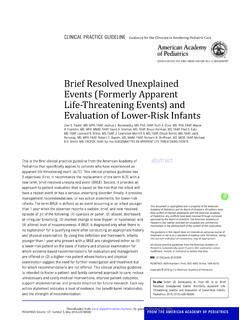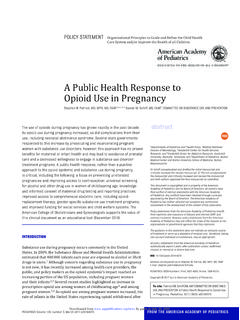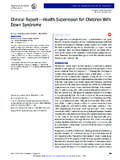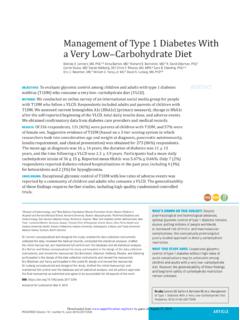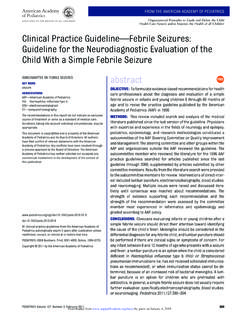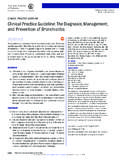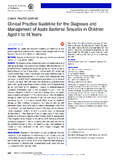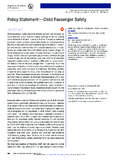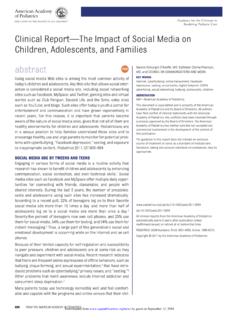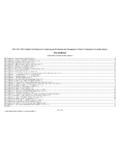Transcription of Health Effects of Energy Drinks on Children, …
1 SPECIAL ARTICLES. Health Effects of Energy Drinks on children , Adolescents, and Young Adults AUTHORS: Sara M. Seifert, BS, Judith L. Schaechter, MD, Eugene R. Hershorin, MD, and Steven E. Lipshultz, MD abstract Department of Pediatrics and the Pediatric Integrative Medicine OBJECTIVE: To review the Effects , adverse consequences, and extent of Program, University of Miami, Leonard M. Miller School of Medicine, Miami, Florida Energy -drink consumption among children , adolescents, and young KEY WORDS. adults. Energy drink, caffeine, taurine, children , adolescents, overdose METHODS: We searched PubMed and Google using Energy drink, . ABBREVIATIONS sports drink, guarana, caffeine, taurine, ADHD, diabetes.
2 FDA Food and Drug Administration children , adolescents, insulin, eating disorders, and poison ADHD attention-de cit/hyperactivity disorder control center to identify articles related to Energy Drinks . Manu- facturer Web sites were reviewed for product information. RESULTS: According to self-report surveys, Energy Drinks are con- Accepted for publication Dec 3, 2010. sumed by 30% to 50% of adolescents and young adults. Frequently Address correspondence to Steven E. Lipshultz, MD, Department of Pediatrics (D820), Leonard M. Miller School of Medicine, containing high and unregulated amounts of caffeine, these Drinks University of Miami, Medical Campus MCCD-D820, 1601 NW 12th have been reported in association with serious adverse Effects , espe- Ave, 9th Floor, PO Box 016820, Miami, FL 33101.
3 E-mail: cially in children , adolescents, and young adults with seizures, diabe- tes, cardiac abnormalities, or mood and behavioral disorders or PEDIATRICS (ISSN Numbers: Print, 0031-4005; Online, 1098-4275). those who take certain medications. Of the 5448 US caffeine over- Copyright 2011 by the American Academy of Pediatrics doses reported in 2007, 46% occurred in those younger than 19. FINANCIAL DISCLOSURE: The authors have indicated they have years. Several countries and states have debated or restricted their no nancial relationships relevant to this article to disclose. sales and advertising. Funded by the National Institutes of Health (NIH).
4 CONCLUSIONS: Energy Drinks have no therapeutic bene t, and many ingredients are understudied and not regulated. The known and un- known pharmacology of agents included in such Drinks , combined with reports of toxicity, raises concern for potentially serious adverse ef- fects in association with Energy -drink use. In the short-term, pediatri- cians need to be aware of the possible Effects of Energy Drinks in vulnerable populations and screen for consumption to educate fami- lies. Long-term research should aim to understand the Effects in at-risk populations. Toxicity surveillance should be improved, and regulations of Energy -drink sales and consumption should be based on appropri- ate research.
5 Pediatrics 2011;127:511 528. PEDIATRICS Volume 127, Number 3, March 2011 511. Downloaded from by guest on February 7, 2018. Energy Drinks are beverages that Given the rapidly growing market and DISCUSSION. contain caffeine, taurine, vitamins, popularity among youth, we re- What Are Energy Drinks ? herbal supplements, and sugar or viewed the literature to (1) deter- sweeteners and are marketed to im- mine what Energy Drinks are, (2) Energy Drinks may contain caffeine, prove Energy , weight loss, stamina, compile consumption data of Energy taurine, sugars and sweeteners, athletic performance, and concen- Drinks by children , adolescents, and herbal supplements, and other ingre- 3 Energy Drinks are available young adults, (3) compile caffeine dients (Table 2) and are distinct from in 140 countries and are the fastest sports Drinks and vitamin waters (Ta- and Energy -drink overdose data, (4).)
6 Growing US beverage market; in 2011, ble 3).6,8 In 2008, the National Federa- examine the physiologic Effects of sales are expected to top $9 10 tion of State High School Associations, the ingredients in Energy Drinks , (5). Half of the Energy -drink market con- while recommending water and identify potential problems of Energy sists of children ( 12 years old), ado- sports Drinks for rehydration, spe- Drinks among children and adoles- lescents (12 18 years old), and young ci cally did not recommend Energy cents, (6) assess the marketing of adults (19 25 years old).7 10 Drinks and cited potential risks, the Energy Drinks , (7) report current absence of bene t, and drug interac- Although healthy people can tolerate regulation of Energy Drinks , and (8).
7 Tions (Table 4).36,37. caffeine in moderation, heavy caffeine propose educational, research, and consumption, such as drinking Energy regulatory recommendations. Caffeine is the main active ingredient Drinks , has been associated with even in Energy Drinks ; many of them contain more serious consequences such as METHODS 70 to 80 mg per 8-oz serving ( 3 times seizures, mania, stroke, and sudden the concentration in cola Drinks ) (Ta- We searched PubMed by using Energy 8,12 14 Numerous reports exist ble 5).8,31 Caffeine content can be drink, sports drink, guarana, caf- in the popular media, and there are a nearly 5 times greater than that in 8 oz feine, taurine, ADHD (attention- of cola Drinks when packaged as en- handful of case reports in the litera- de cit/hyperactivity disorder), diabe- ture that associate such adverse ergy shots ( 3 oz) or as 16-oz tes, children , adolescents, insulin, ,29,38.
8 Events with Energy -drink consump- eating disorders, and poison control tion; it is prudent to investigate the Energy Drinks often contain additional center singly or in combination. We lim- validity of such claims (Appendix). amounts of caffeine through additives, ited searches to English-language and children , especially those with car- including guarana, kola nut, yerba foreign-language articles with English- diovascular, renal, or liver disease, mate, and ,7,14,25 Guarana language abstracts and selected articles seizures, diabetes, mood and behav- (Paullinia cupana) is a plant that by relevance to Energy -drink use in chil- ioral disorders, or hyperthyroidism or contains caffeine, theobromine (a dren and adolescents.)
9 We similarly chronotrope), and theophylline (an those who take certain medications, searched Google for print and trade me- inotrope).39 Each gram of guarana may be at higher risk for adverse dia. We reviewed articles and Internet can contain 40 to 80 mg of caffeine, events from Energy -drink consump- sources by the above search through and it has a potentially longer half- 8,14 24 Although the US Food and June 2010 and updated sections as new life because of interactions with Drug Administration (FDA) limits caf- information became available through other plant ,14 Manufac- feine content in soft Drinks , which are January 2011. turers are not required to list the categorized as food, there is no such regulation of Energy Drinks , which are caffeine content from these ingredi- RESULTS ,14 Thus, the actual caffeine classi ed as dietary 3.
10 Despite the large, unregulated market Two-thirds of the 121 references we dose in a single serving may exceed for Energy Drinks and reports in the found on Energy Drinks were in the sci- that ,29. literature and popular media of seri- enti c literature, although reports by ous adverse events associated with government agencies and interest Consumption of Energy Drinks by their consumption, research into their groups also contained much useful in- children , Adolescents, and Young use and Effects has been formation (Table 1). Most information Adults However, schools, states, and coun- came from the United States, but Euro- In the United States, adolescent caf- tries increasingly are exploring con- pean, Canadian, Australian, New Zea- feine intake averages 60 to 70 mg/day tent and sales regulations of these land, and Chinese sources are also and ranges up to 800 ,40 Most ,8,13,26 35 represented.
